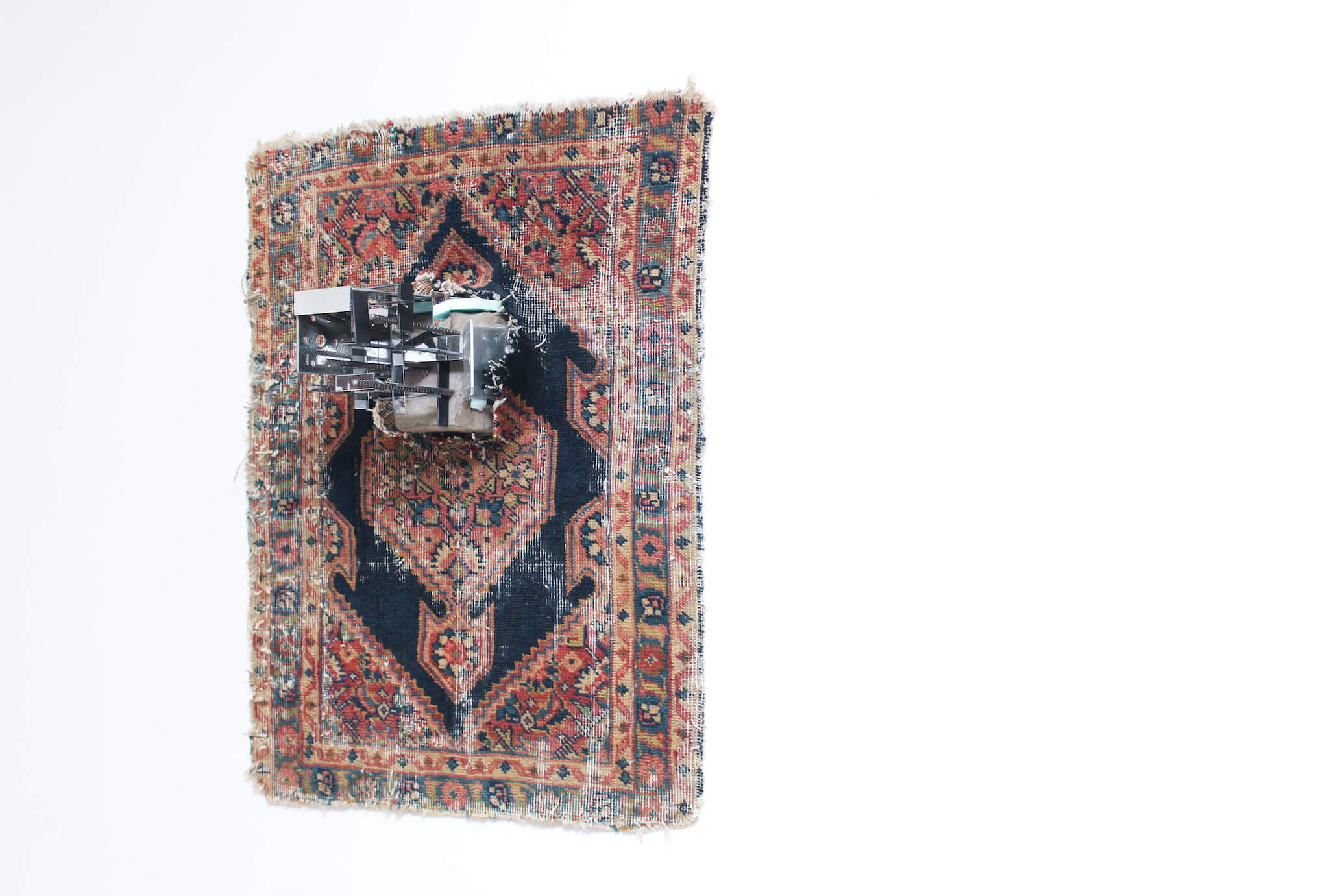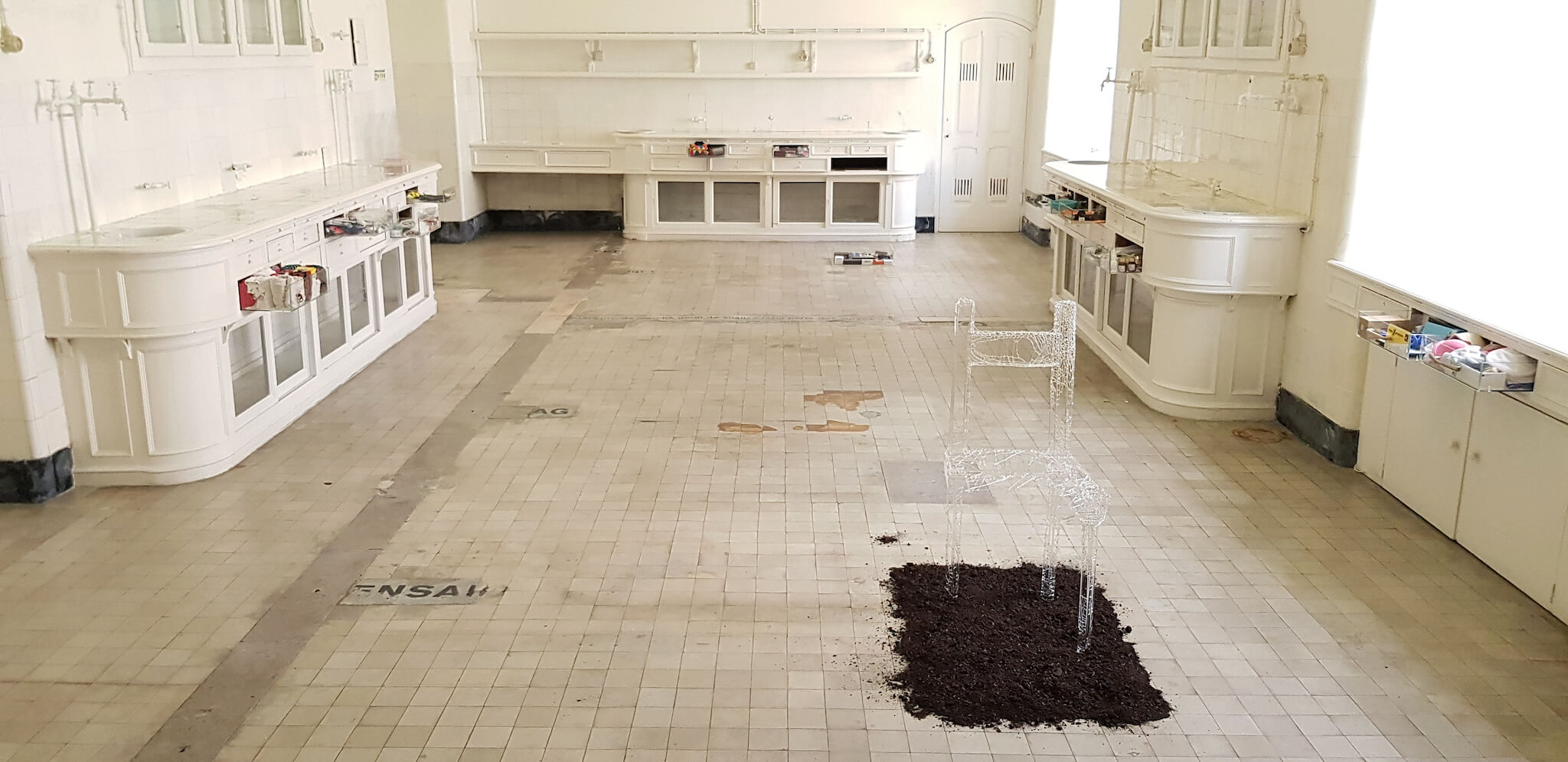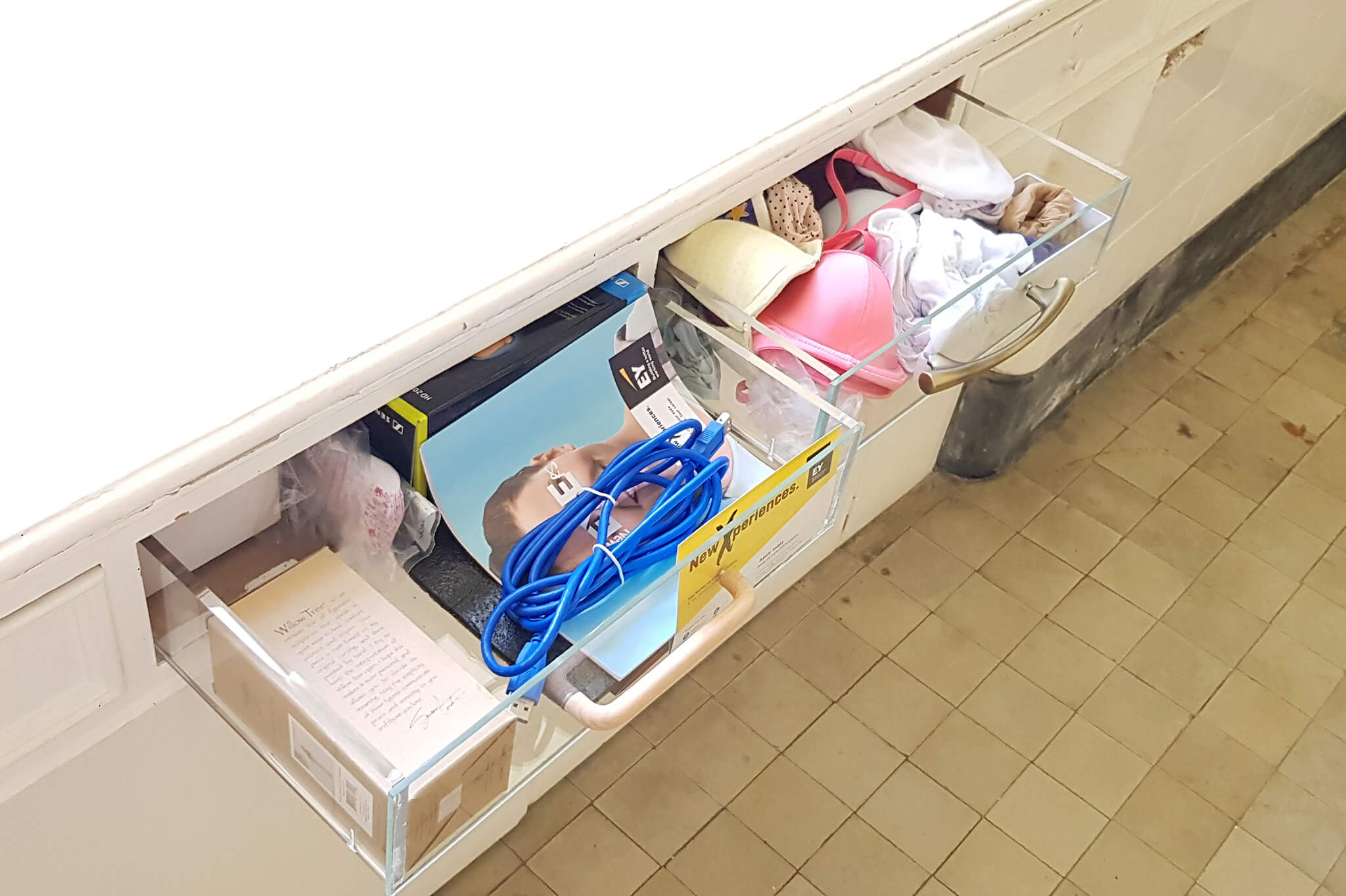In this email exchange between artist Elmira Abolhassani and David Revés, Abolhassani reflects on her unique journey as an Iranian artist living in Portugal, citing its international accessibility and cultural openness. She delves into her multidisciplinary background in industrial design and glass art, revealing how her artistic process intertwines with themes of identity, communication, and self-reflexivity. Abolhassani’s work, characterised by its meticulous attention to materials and subjects drawn from Persian culture, invites viewers to engage with complex narratives of individual and collective experience.
I think that we could start by noticing a very intriguing and relevant fact in your life path. You are an Iranian artist who chose to live in Portugal more than ten years ago and, in the meantime, you have even acquired Portuguese nationality. First of all, I would like to ask you what made you choose Portugal – and specifically Lisbon – to live, considering that these places do not seem particularly important in terms of contemporary art (a condition that, we might think, would discourage an artist from another country to move here). Second, I would like to ask you how the Portuguese cultural rhythms and specificities, as well as its distinct territorial scale and demography compared to Iran, have already influenced your artistic practice, or rather, how you and your work move between such different cultural and societal realities.
This question is always the first concern for Iranian and Portuguese citizens when they find out that I chose to live in Portugal. I think this is because for both countries the other one is somehow unknown. But I see Portugal, specifically Lisbon, as a calm place that can easily access the international art community. It has everything that you need in a small area.
I have always been curious about other cultures, what is happening in other places around the world, or the interconnections between people. We all can see how the politics of some countries have an effect on other countries.
In some cases, like Iran, it is straightforward. But Portugal is one of the last places in the West that I believe preserves its own character. For someone like me, it gives room to think about my project out of the box but within a society that doesn’t have any negative or positive preconceptions about your background.
I came from a country with a history as long as the history of the civilisation itself. Living in Iran as an artist gives you an opportunity to engage with many subjects that can inspire you to create artworks. But, personally, I need a space to think out of the place I am used to being in. For me, Portugal has all of the characteristics that I was looking for.
I got my master’s degree in Glass Art and Science from the Faculty of Fine Arts of the University of Lisbon.
During my master’s studies, I had classmates from all over the world, even Murano, Venice. Because the way you look at the glass is very different from the traditional one. Around the world it is common to use glass as they do in Murano – to make high technique objects. So, there aren’t lots of schools in the world specialising in glass art.
For your second question, I have been curious about humans, identities and cultures for as long as I can remember. Therefore, super-modern countries with a character that I believe is a mere copy of other countries are not the places I want to spend my time in. I love walking in Lisbon and smelling the pastéis de nata or hearing a piece of fado. I don’t know if Portugal has had a direct effect on my artwork, but my background and the atmosphere that this country has are part of me and my art.
Your professional career is also quite distinct and atypical: you are a visual artist who first graduated in industrial design and later did a master’s degree in art and glass technology. That connection is evident in your artistic work, precisely because of a constant interest in and attention to certain objects of daily use, which you appropriate, reformulate, animate, duplicate or invoke. I would like you to tell me a little more about the specificity of this path and those interests.
Before I graduated with a bachelor’s degree in industrial design, I got a diploma in painting, which I think has had a massive role in my journey. Also, I believe objects have different characters, so I tried to feel these differences even when I studied industrial design. For example, why does a customer chose a particular colour, this shape or that material, etc.? All of this gives us information that comes from people’s characters or identities. In other words, you can read people through their choices.
I wanted to go further and understand more about identity, communication and self-reflexivity, and design does not have this capacity. However, all the knowledge and imagination that help me create my installations come from my experience as an industrial design student. The nature of glass can be transparent or opaque, hard or soft, melting hot or solid, which gave me an opportunity to think beyond the objects.

At certain times you are interested in precise material elements of daily life – which in your work come mainly from the symbolic fabric of Persian culture – though this is not always the case. Other times you address specific social events or movements whose material delimitation is less evident, as is the case with The Silent Hands that you are currently exhibiting on Sumac Space. There I find a political dimension to your work but above all it also intends to act within the articulations of an oikonomy of appearances, characterising and established within a certain culture. In that sense, I would even dare to say that your work is less about objects as autonomous material forms than about subjective networks, or even a collective unconscious, of which they are expression and a result.
I am working on three rings of a single chain – identity, communication and self-reflexivity – and I express them in all the ways I can. I try to know each material’s properties and use them in my work, but the subject is my priority.
Therefore, although we witness the use of a wide range of materials in my work, the time I spend researching the subject is far more than the actual making of the work.
For example, The Silent Hands is still an ongoing project. I have spent at least three years researching Afghan immigrants who live in Iran and other countries. Almost every day, I have an interview with someone from Afghanistan, or I talk to other artists or journalists working on this subject. The collection of sounds becomes more abundant and more prosperous. On the other hand, I only spent one month making the glass part of the installation.
Despite all this, it is unquestionable how you wanted to become an expert craftswoman, namely regarding glass, a material that you master with extreme accuracy and wisdom. I would like you to tell me a little more about your relationship with glass, its techné and the intuitive processes that are established, in addition to the way this material assumes a special predominance in your artistic practice.
I have experience using wood, plaster, metal, plastic, ceramic and a lot more with my industrial design background.
But I believe working with glass is technically the hardest one to master because what you can do with glass is done in a very short time and in a sweltering place like a furnace or the flame of a glass torch.
Also, because of the thermal shock, you never know what will happen in the next second. So, you need to have lots of patience. I try to find myself while trying to master glass. Glass is a material, a living creature that you have to befriend to be able to work with. In glass science, there are lots of different types of glass, and each of these types has its own behaviour in terms of heat, annealing time, etc., which I think is just like different people’s personalities.
It is true that I am a professional glass maker, but again I use all the skills and materials that I have as a tool for sending my message to my audience. It is easy for me to make a work that everyone marvels at because of its delicacy or its craft aspects. But I am trying to avoid making crafts.

Let’s look at the mirror, another element that frequently recurs in your work and that immediately establishes an intimate relationship with glass itself. I noticed that you invoke it within some associations with certain elements of traditional Persian architecture, but it seems to me that, above all, the way you use the mirror (and mirroring) establishes a mechanism that destabilises its traditional moralising or dominating role in a closed process of individuation. When using mirrors, you are asking us to do the opposite of that, showing that the real and the individual are composed of a myriad of never-stable fragments that always recompose and update depending on the positional dynamic character of a relationship. There I see a strong ethical sense – an ethos – in the core of your poetics, which inevitably develops, as a political proposition for the contemporary world and of the forms of constructional subjectivity.
I can’t analyse myself or even my work the way that other people can do because they are a part of me and my life journey. But I can tell you about some issues that I have been interested in since I was a child and then I can see how they have affected my work.
I was born in Mashhad, the second largest city in Iran. The biggest holy shrine in the world is there; it is one of the most popular destinations for many people. Because of all the trade happening there, Mashhad is one of the main economic hubs in Iran with a huge turnover. From when I was a child, I can remember believers from all over the world coming there to pray. Their reflection on mirror mosaics on the holy shrine’s walls and the whisper of them meant something for me. Many years later, we can see the mosaics emerging in my work. In another example, we see merchants from our neighbouring countries on the street with their traditional clothes.
Politics and history have always been my concerns. But, as a citizen who lived in Mashhad, I witnessed all the ups and downs that happened in the Middle East. With each war, we have seen immigrants flooding our city, and I deeply believe we, as humans, have an impact on other people’s lives. One of the reasons I migrated to Portugal was that I wanted to have a better perception of the human network and interconnection between people. The political flavour in my work comes from my experience and the way I look at the world.

There is yet another evidence, at least in the relationship I have established with your work, that I think is interesting to underline about your poetics. Despite your keen interest in sociocultural forms and structures, in the objects that are born in the Middle East, as well as in the processes of constructing individual and collective bodies within the world, there is always something that is present and seems to escape – almost in a Nietzschean sense of both construction and implosion of shapes1. That, I would say, could be located in the vocation that your work has in bringing together the chaotic forces of the Earth, an ambivalence between life, will and destruction, that always overcome any attempt to control or stabilise the forms of culture and the supremacy of the individual.
I totally agree with your interpretation. Every day I look for questions, and art is just a tool to express myself. But the more I proceed, the more I realise that I know less. I am proud to be aware of this emptiness. Lots of us are fighting for things that we believe in, but the truth can be the complete opposite of that.
I try to bring these questions to people’s minds with my work: How can I criticise my beliefs? or Do my beliefs reflect reality?
This ambivalence about what I know generates the form of my work. NAVIGATE THROUGH ELMIRA ABOLHASSANI’S ARTIST’S ROOM.
1 F. Nietzsche, Nietzsche Werke. Sämtliche Werke. Kritische Studienausgabe, 15 volumes. Edited G. Colli and M. Montinari, Berlin: Walter de Gruyter, 1980.
Elmira Abolhassani, b. 1989, Mashhad, Iran.
Lives and works in Lisbon, Portugal.
Abolhassani holds a master’s degree of glass art and science from the Lisbon Fine Art University. The ultimate purpose of her artistic journey, to date, has been to understand how human networks and identities are formed and what their underlying structure is. Her works reflect her attempt to understand the meaning of network systems and, in particular, her role and position – as an individual node – in this complex web, as well as the nature of her artistic task as an interpreter of this all-encompassing network. Her works and thoughts stem from her belief that we must first attain a clear vision of ourselves in order to apprehend significant aspects of our world.
Therefore, as a visual artist who uses glass as the primary material in her works, she tries to find herself while trying to master glass. Glass is a material that can be soft or hard, transparent or opaque, solid or liquid: a living creature that you have to befriend to be able to work with. However, as an artist, she uses any object that can demonstrate her concerns.
Her works have been exhibited in both solo and group exhibitions in international galleries and institutions such as S12 Gallery, Bergen, Norway (2019); Redgate Gallery, Beijing, China (2019); National Museum of Natural History and Science, Lisbon, Portugal (2018); and the City Museum, Almada, Portugal (2016).
David Revés, b. 1992, Lisbon, Portugal.
Lives and works in Lisbon.
Revés is an art critic, independent curator, and researcher. He holds a master degree in Art Studies – Art Theory and Criticism (University of Porto, Portugal) and is studying for a master degree in Communication Science – Contemporary Culture and New Technology (NOVA University, Lisbon, Portugal). David has explored the field of new media and is interested in the way it entwines with art, exhibiting devices and politics of the image. He writes critiques and essays, contributing regularly to several publications, as well as artistic and academic projects.
Sumac Dialogues is a place for being vocal. Here, authors and artists get together in conversations, interviews, essays and experimental forms of writing. We aim to create a space of exchange, where the published results are often the most visible manifestations of relations, friendships and collaborations built around Sumac Space. If you would like to share a collaboration proposal, please feel free to write us. We warmly invite you to follow us on Instagram and to subscribe to our newsletter and stay connected.